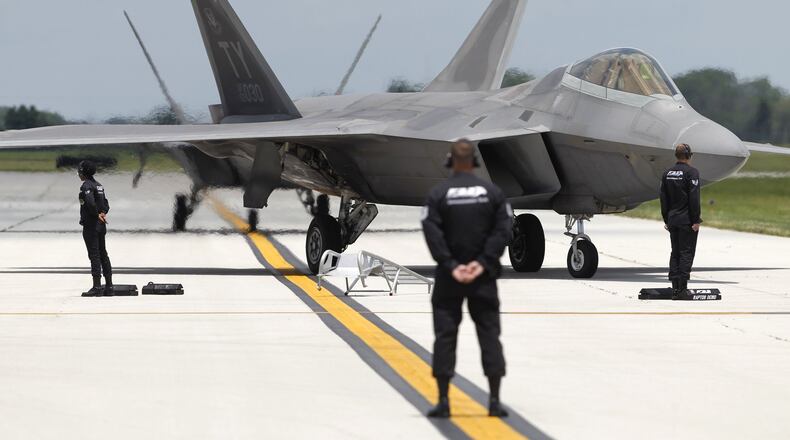RELATED: Trump budget calls for $3.6T in spending cuts, boost to defense
The proposed defense budget is a $52 billion increase over defense spending caps imposed under sequestration, and a 3 percent hike over an Obama administration plan, defense officials said. The budget proposes $574.5 billion in baseline spending and an additional $64.6 billion in wartime spending for overseas operations.
“This is not a historic buildup but a repair budget,” defense analyst Mackenzie Eaglen of the conservative American Enterprise Institute, said in an email. “The president’s request is attempting to plug the holes and fill the gaps across the Defense Department and military services.”
‘Will not be enough’
While the budget increase stands out against cuts to many domestic programs, some defense hawks said the amount proposed doesn’t reach the levels necessary to rebuild the military, restore readiness and address combating terrorism and rising adversary threats.
“While I support President Trump’s commitment and intent to rebuild the military, this budget request will not be enough to do what he has said is needed to improve military capabilities and readiness,” U.S. Rep. Mike Turner, R-Dayton, a member of the House Armed Services Committee, said in a statement.
A Pentagon official defended the size of the increase in a briefing Wednesday.
RELATED: Exclusive: Top Air Force general says ‘all programs at risk’
“Fifty-two billion is not chump change,” said Defense Department Comptroller John P. Roth. “We’re not going to solve the readiness problem in one year. We’re not going to modernize in one year.”
Under the Trump administration proposal, Air Force spending would rise to a total of $183 billion compared to $171.1 billion this fiscal year, and add 4,100 airmen and dozens of F-35 fighter planes, documents show. Acquisition spending, a key mission at Wright-Patterson Air Force Base, would also rise. Research and development spending would be “stable,” said Michael Gessel, Dayton Development Coalition vice president of federal programs.
“On its face, it looks like good news for Wright-Patt,” but Congress isn’t likely to pass the federal budget President Donald Trump wants, said Loren B. Thompson, a senior defense analyst with the Virginia-based Lexington Institute and a defense industry consultant.
Gessel said the budget “positions Wright-Patterson for future growth.” He also said the defense plan is significant because it marks the first time the Trump administration asked for a round of base closures.
The budget did not include any major military construction dollars for Wright-Patterson.
RELATED: Air Force responds to Trump over Air Force One costs
The Air Force has struggled to restore readiness levels, which dropped to “historically low levels” four years ago and “will take years to fully rebuild,” an Air Force budget document says. The military branch wants to boost incentives to pilots and mechanics to reverse manpower shortages in the ranks.
Airmen in uniform would receive a 2.1 percent hike in military pay and civilian employees a 1.9 percent pay boost under the proposal. Military personnel would receive a 3.2 percent hike in a housing subsidy and 3.4 percent for basic allowance for subsistence, budget documents show.
More airmen in the ranks
The administration’s Air Force budget proposal raises the number of active duty airmen to 325,100, up 4,100 troops versus the prior year. The Air Guard would add 900 — boosting troop strength to 106,600 — while the Air Force Reserve would add 800, for a total of 69,800.
Research, development, test and evaluation spending would jump sharply to $25.4 billion, from $20.2 billion this year.
Procurement spending would jump to a total of $42 billion, an increase of about $1.1 billion compared to the current fiscal year.
The service branch plans to purchase 46 F-35A Joint Strike Fighters, part of a Defense Department plan to buy 70 of the jets for $10.3 billion.
The Air Force would purchase 15 KC-46 Pegasus refueling tanker jets for $3.1 billion, and spend $2 billion on research and development of the future B-21 Raider stealth bomber, the top acquisition priorities in addition to the controversial F-35, which has faced cost overruns and technical delays.
In a closely watched Wright-Patterson managed program criticized by Trump, spending on development of a future Boeing 747-8 to replace the current fleet of two presidential jets will rise to $434 million versus $322 million the year prior.
The budget spends millions to update the F-22 Raptor, F-16 Fighting Falcon and the F-15 Eagle and unmanned drones. It removes a retirement date for the long-serving U-2 spy plane.
Dead on arrival?
Eaglen acknowledged the proposals won’t get through Congress without revision.
“Members from Sen. (John) McCain to Sen. (John) Cornyn have said this budget is straight up DOA. They’re right,” he said. “But it is still a useful framing document for where DoD will invest the money once it comes even though that is likely a long time from now.”
About the Author
